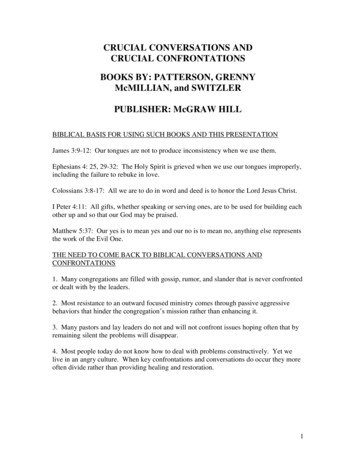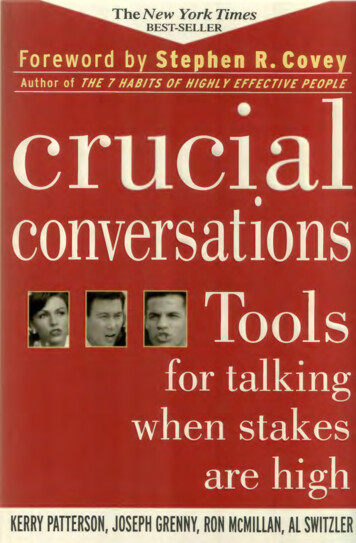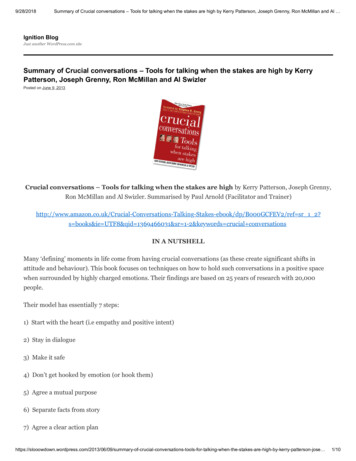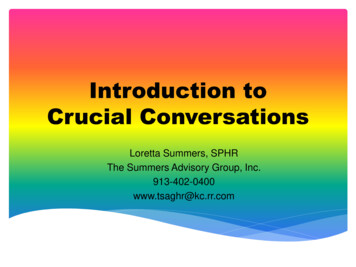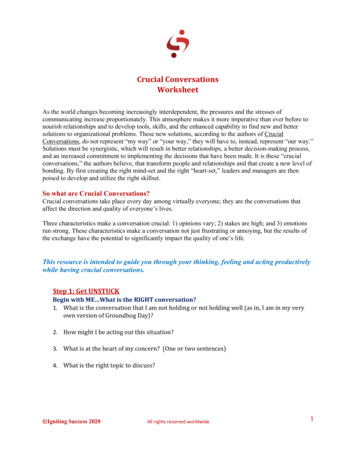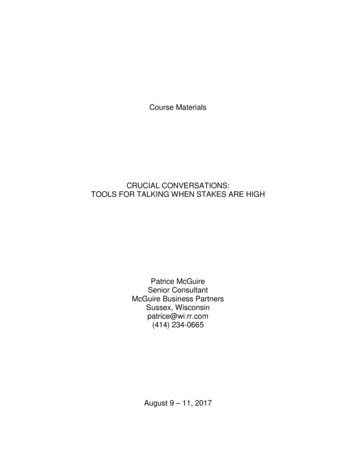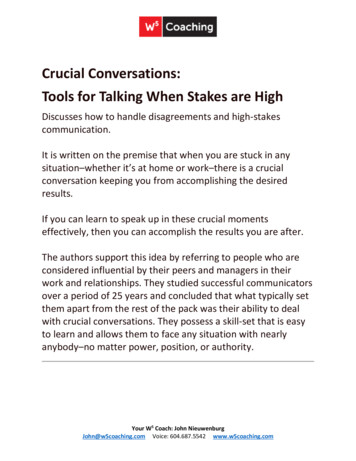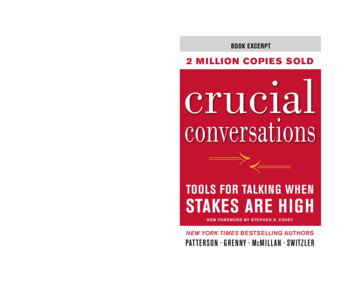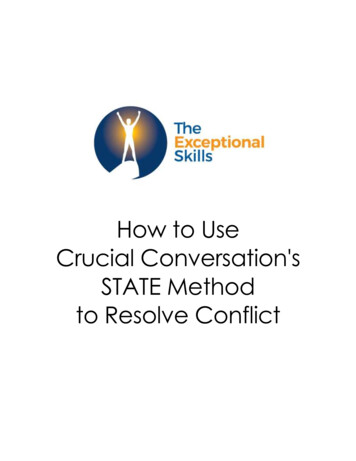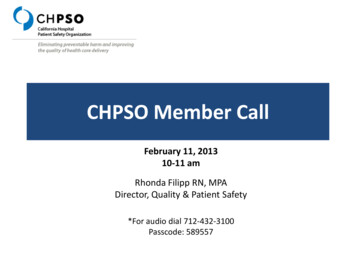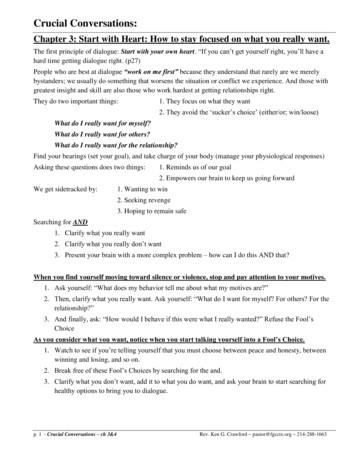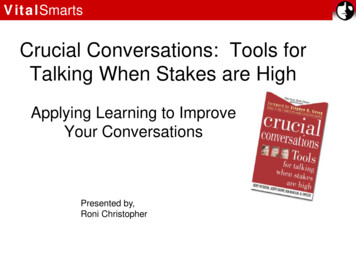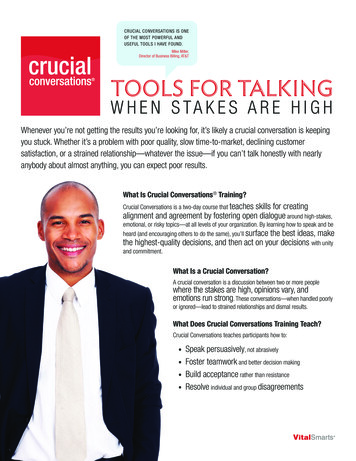
Transcription
CRUCIAL CONVERSATIONS IS ONEOF THE MOST POWERFUL ANDUSEFUL TOOLS I HAVE FOUND.Mike Miller,Director of Business Billing, AT&TTools for TalkingW H E N S TA K E S A R E H I G HWhenever you’re not getting the results you’re looking for, it’s likely a crucial conversation is keepingyou stuck. Whether it’s a problem with poor quality, slow time-to-market, declining customersatisfaction, or a strained relationship—whatever the issue—if you can’t talk honestly with nearlyanybody about almost anything, you can expect poor results.What Is Crucial Conversations Training?Crucial Conversations is a two-day course that teachesskills for creatingalignment and agreement by fostering open dialogue around high-stakes,emotional, or risky topics—at all levels of your organization. By learning how to speak and beheard (and encouraging others to do the same), you’ll surface the best ideas, makethe highest-quality decisions, and then act on your decisions with unityand commitment.What Is a Crucial Conversation?A crucial conversation is a discussion between two or more peoplewhere the stakes are high, opinions vary, andemotions run strong. These conversations—when handled poorlyor ignored—lead to strained relationships and dismal results.What Does Crucial Conversations Training Teach?Crucial Conversations teaches participants how to: Speak persuasively, not abrasivelyFoster teamwork and better decision makingBuild acceptance rather than resistanceResolve individual and group disagreements
About the BookWho Needs Crucial Conversations Training?With more than 2 million copiessold, Crucial Conversations isthe New York Times businessbestseller that’s transformedorganizations and changedthe way millions of peoplecommunicate.Does your organization suffer from taboo topics, deference, disagreement,analysis paralysis, information hoarding, office politics, or alienation? Is yourorganization battling declining productivity, safety violations, low morale, reducedquality, poor customer satisfaction, or other bottom-line concerns? Then you,your team, or your organization needs Crucial Conversations Training.Participant Materials Crucial Conversations Participant Toolkit Cue cards for each lesson in a desktopdisplay case Crucial Conversations model card A copy of the New York Times bestselling book,Crucial Conversations: Tools for Talking WhenStakes are High (2nd Edition) Crucial Conversations Audio Companion A course completion certificateTraining Options In-house—One of our experts trainsthe program at a location you specify.Organizational Benefits of Crucial ConversationsFortune 500 organizations around the world have turned to the award-winning CrucialConversations Training to improve bottom-line results like quality, efficiency, satisfaction,safety, etc. Results include: Productivity & Quality. Sprint Nextel saw a 93 percent improvement inproductivity and a 10 to 15 percent improvement in quality, time, and cost. Teamwork. Employees at MaineGeneral Health were 167 percent more likelyto speak up and resolve problems with colleagues after being trained in CrucialConversations. Relationships. Franklin Pierce College reduced passive-aggressive behavior by14 percent and increased trust levels by 15 percent. Performance. STP Nuclear Power Plant went from total shut-down to generatingthe most electricity in the nation among two-unit plants. Efficiency. AT&T reduced billing costs by 30 percent and Sprint Nextel reducedcustomer care expenses by 20 million annually. Public Workshop—Your employeesattend a prescheduled, public trainingworkshop. Both virtual and in-persontraining options are available. Trainer Certification—Individuals ortrainers from your organization certify toteach the course within your company.Certified trainers can also train theSmall Group Virtual Classroom course inpartnership with the VitalSmarts virtualproduction team.Want to Customize this Course?We offer multiple options to both personalizeour training to meet your specific needs, aswell as measure its impact. Learn more at www.vitalsmarts.com/tailormeasureNamed “Training Product of the Year”Human Resource ExecutiveDon’t Take Our Word for ItMore than 1.5 people and 300 of the Fortune 500 companies have used ourskills to improve their organizational culture and create change for good.What’s the Next Step?If your organization could benefit from the skills taught in Crucial ConversationsTraining, contact us today to learn more. Call 1-800-449-5989 or visit us atwww.vitalsmarts.com.About VitalSmarts. An innovator in corporate training and leadership development, VitalSmartscombines three decades of original research with 50 years of the best social science to help leadersand organizations change human behavior and achieve new levels of performance. We’ve identifiedfour high-leverage skill sets that, when used in combination, create healthy corporate cultures.These skills are taught in our award-winning training programs and New York Times bestsellingbooks of the same titles: Crucial Conversations, Crucial Accountability, Influencer, and ChangeAnything. VitalSmarts has worked with 300 of the Fortune 500 companies and trained more than1.5 million people worldwide. www.vitalsmarts.comThe Crucial Skills SuiteThose who have already attended the two-dayCrucial Accountability course may add on theone-day Crucial Conversations course. Visit 2015 VitalSmarts. All Rights Reserved. VitalSmarts, the Vital head, Crucial Conversations, and Influencer Trainingare registered trademarks and Crucial Accountability and Change Anything are trademarks of VitalSmarts, L.C.
CRUCIAL CONVERSATIONS MODELBEFOREWORK ON ME FIRSTGet UnstuckStart with HeartMaster My StoriesDURINGMY MEANINGSTATE My PathSILENCESA F E T YPOOL ofSHAREDMEANINGTHEIR MEANINGLearn to LookMake It SafeExplore Others’ PathsSAFETYVIO L E N C EAFTERMOVE TO ACTIONWho does What by WhenFollow up 2014 VitalSmarts. All Rights Reserved.
WHAT IS YOUR STYLE UNDER STRESS ? From the New York Times bestsellerCrucial Conversations:Tools for TalkingWhen Stakes are HighHow do you react when conversations suddenly move from smoothand easygoing to tense or awkward? Do you retreat into silence? Do you go onthe attack? Or do you do your best to keep the conversation calm and focusedon the issues at hand?Crucial conversations take place when the stakes are high, opinions differ, andemotions run strong. Handling crucial conversations well can dramatically improveyour personal relationships, your career progress, and your work team’s performance.Take this 33-question test to explore how you typically respond when you’re inthe middle of a stressful situation. Have your friends, colleagues, or familymembers take the test as well. The answers may surprise you.A self-scoring version of this test is available online at www.vitalsmarts.com/styleunderstress. Information on what your score means can be found on pages68-69 of the New York Times bestseller Crucial Conversations: Tools for TalkingWhen Stakes are High.“When we usecrucial conversations skills,we can influence decisions,improve relationships,and speak our mindsin a way that gets heard.”- Joseph GrennyInstructionsBefore you start, read through the following points: RELATIONSHIPThink about the relationship you want to improve—with your boss, coworker, direct report, friend, or family member—and keep this relationship in mind. CIRCUMSTANCENext, think of a tough situation—one you might havehandled poorly or avoided altogether. APPLYNow, with that situation in mind, respond to the statements onthe following pages as either true or false.
Style Under Stress Test TF1. At times I avoid situations that might bring me intocontact with people I’m having problems with.TF2. I have put off returning phone calls or e-mailsbecause I simply didn’t want to deal with theperson who sent them.TTTTTTTTFFFFFFFFTF13. When I’m discussing an important topic withothers, sometimes I move from trying to make mypoint to trying to win the battle.TF14. In the middle of a tough conversation, I often getso caught up in arguments that I don’t see howI’m coming across to others.TF4. When it comes to dealing with awkward orstressful subjects, sometimes I hold back ratherthan give my full and candid opinion.15. When talking gets tough and I do somethinghurtful, I’m quick to apologize for my mistakes.TF5. Rather than tell people exactly what I think,sometimes I rely on jokes, sarcasm, or snideremarks to let them know I’m frustrated.16. When I think about a conversation that took a badturn, I tend to focus first on what I did that waswrong rather than focus on others’ mistakes.TF6. When I’ve got something tough to bring up,sometimes I offer weak or insincere complimentsto soften the blow.17. When I’ve got something to say that others mightnot want to hear, I avoid starting out with toughconclusions, and instead start with facts that helpthem understand where I’m coming from.TF7. In order to get my point across, I sometimesexaggerate my side of the argument.18. I can tell very quickly when others are holdingback or feeling defensive in a conversation.TF8. If I seem to be losing control of a conversation,I might cut people off or change the subject inorder to bring it back to where I think it should be.19. Sometimes I decide it’s better not to giveharsh feedback because I know it’s bound tocause problems.TF9. When others make points that seem stupid to me,I sometimes let them know it without holding backat all.20. When conversations aren’t working, I step backfrom the fray, think about what’s happening, andtake steps to make it better.TF21. When others get defensive because theymisunderstand me, I immediately get us back ontrack by clarifying what I do and don’t mean.TF22. There are some people I’m rough on because, tobe honest, they need or deserve what I give them.3. Sometimes when people bring up a touchy orawkward issue I try to change the subject.10. When I’m stunned by a comment, sometimes Isay things that others might take as forceful orattacking—terms such as “Give me a break!” or“That’s ridiculous!”TF11. Sometimes when things get a bit heated I movefrom arguing against others’ points to sayingthings that might hurt them personally.TF23. I sometimes make absolute statements like “Thefact is ” or “It’s obvious that ” to be sure mypoint gets across.TF12. If I really get into a heated discussion, I’ve beenknown to be tough on the other person. In fact,they might even feel a bit insulted or hurt.TF24. If others hesitate to share their views, I sincerelyinvite them to say what’s on their mind, no matterwhat it is.
TF25. At times I argue hard for my view hoping to keepothers from bringing up opinions that would be awaste of energy to discuss anyway.TF26. Even when things get tense, I adapt quickly to howothers are responding to me and try a new strategy.TF27. When I find that I’m at cross purposes withsomeone, I often keep trying to win my way ratherthan looking for common ground.TF28. When things don’t go well, I’m more inclined to seethe mistakes others made than notice my own role.TF29. After I share strong opinions, I go out of my wayto invite others to share their views, particularlyopposing ones.TF30. When others hesitate to share their views, I dowhatever I can to make it safe for them to speakthonestly.TF31. Sometimes I have to discuss things I thought hadbeen settled because I don’t keep track of whatwas discussed before.TF32. I find myself in situations where people get theirfeelings hurt because they thought they wouldhave more of a say in final decisions than they endup having.TF33. I get frustrated sometimes at how long it takessome groups to make decisions because toomany people are involved.ScoringFill out the following score sheets. Each domain contains two tothree questions. Next to the question number is either a (T) or(F). For example, under “Masking,” question 5, you’ll find a (T). Ifyou answered question 5 true, check the box. With question 13,on the other hand, you’ll find an (F). Only check that box if youanswered the question false—and so on. Finally, add the numberof checks in each column to determine your total score.Your Style Under Stress score will show you which formsof silence or violence you turn to most often. Your CrucialConversations Skills score is organized by concept and chapterfrom the book Crucial Conversations: Tools for Talking WhenStakes are High so that you can decide which chapters willbenefit you the most. Again, a self-scoring version of this test isavailable at www.vitalsmarts.com/styleunderstress. Thistest is also duplicated on pages 63-69 of Crucial Conversations.Style Under StressYour silence and violence scores give you a measure of howfrequently you fall into these less-than-perfect strategies. It’sactually possible to score high in both. A high score (one or twochecked boxes per domain) means you use this technique fairlyoften. It also means you’re human. Most people toggle betweenholding back and becoming too gLabeling3(T)9(T)4(T)10 ( T )WithdrawingAttacking1(T)11 ( T )2(T)12 ( T )Silence TotalViolence Total
Crucial Conversations SkillsConclusionThe seven domains below reflect your skills in each ofthe corresponding seven skill chapters found in CrucialConversations: Tools for Talking When Stakes are High. If youscore high (two or three boxes) in one of these domains, you’realready quite skilled in this area. If you score low (zero or one),you may want to pay special attention to these chapters.Since these scores represent how you typically behave duringstressful or crucial conversations, they can change. Your scoredoesn’t represent an inalterable character trait or a geneticpropensity. It’s merely a measure of your behavior—and you canchange that.Here are two ways to improve your skills:Start with Heart(chapter 3)STATE My Path(chapter 7)13 ( F )17 ( T )19 ( F )23 ( F )25 ( F )29 ( T )TotalTotalLearn to Look(chapter 4)Explore Others’ Paths(chapter 8)14 ( F )18 ( T )20 ( T )24 ( T )26 ( T )30 ( T )TotalTotalMake It Safe(chapter 5)Move to Action(chapter 9)15 ( T )31 ( F )21 ( T )32 ( F )27 ( F )33 ( F )TotalTotalMaster My Stories(chapter 6)16 ( T )22 ( F )28 ( F )Total 2013 VitalSmarts. All Rights Reserved. VitalSmarts, the Vital head, Crucial Conversations, and Influencer Trainingare registered trademarks and Crucial Accountability and Change Anything are trademarks of VitalSmarts, L.C. ATTEND TRAININGCrucial Conversations is an award-winning, two-day coursethat teaches skills for fostering open dialogue around highstakes, emotional, or risky ining FREE NEWSLETTEROne of our best learning resources is our free, weeklye-newsletter. Subscribers of the Crucial Skills Newsletterreceive expert instruction from our bestselling authors onhandling real-life crucial conversations.www.crucialskills.com
ConversationPlannerUse the following worksheet to plan your next crucial conversation.Get Unstuck1. Where do you feel stuck (personally or professionally)?2. Unbundle with CPR. Identify:Content Issues:Pattern Issues:Relationship Issues:Which issue do you need to address, and with whom, in order to get unstuck?Start with Heart1. What do you really want:For yourself?For the other person?For the relationship?For the organization (if applicable)?Master My Stories1. What stories are you telling yourself about the situation or the person (Victim, Villain, Helpless)? 2014 VitalSmarts. All Rights Reserved.
2. Tell the rest of the story. Ask:a. What am I pretending not to notice about my role in the problem?b. Why would a reasonable, rational, and decent person do this?c. What should I do right now to move toward what I really want?STATE My Path1. Create a script for how you will begin the conversation. Start with facts, then tell your story, and be sure to end with a question thatinvites the other person into dialogue.THE FACTSMY STORYTHE QUESTION I’LL ASKMake It Safe1. What’s the worst possible response you could get with your crucial conversation?2. What safety skills would you use to address it (apology, contrast, create mutual purpose)?3. If the other person misunderstands your intent, what is a contrasting statement you could use?Don’t:Do:Explore Others’ Paths1. How could you use the “AMPP” (Ask, Mirror, Paraphrase, Prime) skills to help the other person come out of silence or violence?Move to Action1. How will you establish a way to follow up after the crucial conversation?Who:Will do what:By when:How we’ll follow up:
THELAWOF CRUCIALCONVERSATONSPOOL ofMOVE TO ACTIONSAFET’SHAREDMEANINGSAFETYGet UnstuckStart with HeartMaster My StoriesWORK ON ME FIRSTAnytime you f/nd yourself stuck, there s a crucial conversationyou’re either not holding or not holding well.BEFOREDURINGMY MEANINGSTATE My PathAFTERWho does What by WhenFollow upLULLLULUIResults and Relationshipsare suffering.SITUATION12If you are getting emotionalor telling clever stories.You need to initiate aCrucial Conversation, orone is evolving.3PRINCIPLES & SKILLSYou need to hold a Crucial Conversation. Identify where you are stuck, unbundle with CPR.Start with HeartFocus on What You Really Want for: you, them, the relationship,and the organization (your long-term results).?“we’re both happy?”“This is why] want,—Master Your ‘Clever” Stories—Tell the Rest of the StoryVictim Story:“What am I pretending not to notice about my role in the problem?”‘Why would a reasoiabe, ratonal, dece9 person do this?”Villain Story:Helpless Story:“What shoud I do rght “‘ow to move toward wha: I really want?’STATE Your PathShare your Facts: “1 noticed ““Twice youTell your Story: i’m beginning to wonder if“It seems to meAsk for Others’ Paths: “How do you see it?” ‘Help me understand.Talk Tentatively: Own your story and avoid absolutes.Encourage Testing: “Do you see it differently?”(their fear/misunderstanding).”(your actual purpose/meaning). For the signs that a conversaton is turning crucial. For ear:y warning signs of silence and violence.If you have a toughmessage, be honest andmaintain safety.Learn to Look45Contrast“1 don’t thin’mean/want“I do thinI’mean/wantCreate Mutual PurposeCommit to seek Mutual Purpose“Can we look for something we both agree on?”“Why do you wantRecognize the Purpose behind the Strategy.Invent a Mutual Purpose.“So, if you getand I getBrainstorm new strategies.“What ideas do you have?”” I was thinking it may help ifJ”Move to Action—Determine Who, does What. by When, and howwe will Follow up.Prime: “Do you think thatExplore Other’s PathsAsk: “I want to know what you think aboutMirror: (Silence) “You seem reluctant, Are you sure you’re OK with it?”fViolence) “Wow, you seem really upset. What’s up?”Paraphrase: “So you’re saying--Others are already insilence or violence and youmissed the early warning signs.6If someonemisunderstands your intentregarding Purpose or Respect.7The discussion is going incircles. People are arguing.You’re beginning a toughproject or discussion.8When you’re ready to Moveto Action.If someone else is going toSilence or Violence, theirfull meaning isn’t getting intothe Pool.9
Crucial Conversations TipsTip One: Get Unstuck Anytime you find yourself stuck, there are crucial conversations you’re either otholding or not holding well.Tip Two: Start with Heart The first step toward better results is a change inheart—which begins when you admit that you may be part of the problem.ww.vttalsirrarts,conr 800.449.5989VitaiSmartsCall 1 -800-449-5989 for more information.sooner you catch problems, the sooner you can return to dialogue.Tip Three: Learn to Look Watch for the signs that a conversation is turning crucial. Remember, thec3 201 2 Vitaibmarts, L C All rights resersed No nurt of this material may be copied or reproduced without theexpress written permission of Vitalttrnarts. The Vital tread ix a registered trademark ot VrtalSmartsCRUCIAL CONVERSATIONS IS ONEOF THE MOST POWERFUL ANDUSEFUL TOOLS I HAVE FOUND.Mike Miller,Director of Business Billing.AT&TSKLL SUMMARYcrucial PRESENTATIONconversationsVitaiSmarts
Crucial Conversations is a two-day course that teaches skills for creating alignment and agreement by fostering open dialogue around high-stakes, emotional, or risky topics—at all lev
